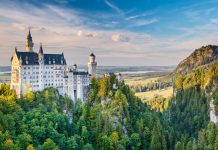The natural landscape of Bulgaria is diverse, consisting of lowlands, plains, foothills and plateaus, river valleys, basins, and mountains of varying elevations. About 70% of the country’s territory is hilly land and 30% is mountainous. The average elevation of the country’s territory is 467 m, generally decreasing from south to north and from west to east.
In the central part of the country lies the Balkan Mountain Range, where the highest peak is Botev (2,376 m). From south to north, its western area is crossed by the Iskar River, which forms a picturesque gorge more than 70 km long. The northern arm of the Balkan Mountains is mainly karst. The highest peak in this range is Vasilyov (1,490 m).
To the south of the Balkan Mountains are the western Balkan valleys and the Srednogorie (central mountainous region). The largest valley in the southern arm of the Balkans is the Sofia valley, the location of the Bulgarian capital Sofia. The mountains in the Srednogorie are the Zavalsko-Planska Range, the Ihtimansko Srednogorie, the Sashtinska Sredna Gora, and the Sarnena Gora.
Between the northern arm of the Balkans and the Danube River lies the Danube valley, with an area of roughly 31,000 square meters. Its eastern part consists of plateaus – the Dobrudzha plateau, the Plovadia plateau, the Lilyak plateau, and the Shumen plateau, among others. To the north lie the Trans-Danube lowlands, which occupy the terraces of the Danube river.
To the south of the capital Sofia rises the mountain Vitosha, whose highest peak is Cherni Vrah (2,290 m). Its foothills extend to the middle part of western Bulgaria, where low-lying and medium-elevation mountains alternate, such as Ruy, Milevska, Zemenska, Konyavska, Verila, and others. West of the Struma River valley and south of Kraishteto is the Osogovo-Belasishka mountain range, which includes the peaks of Osogovska (Mount Ruen, 2,251 m), Vlahinska, Maleshevska, Ograzhden and Belasitsa (Mount Radomir, 2,029 m).
The highest Bulgarian mountains are in the Rila and Pirin ranges, situated to the east of the Struma River valley. The average elevation of these mountains is 1,258 m, and 60% of their area is higher than 1,000 m. In Rila there are 31 peaks with an altitude of over 2,600 m. The highest peak on the Balkan Peninsula, Musala (2,925 m), is located there.
There are two peaks of over 2,600 m elevation in the Pirin range. One is Mount Vihren (2,914 m) – the second highest peak in Bulgaria and the third highest peak on the Balkan Peninsula. Beautiful alpine glacial lakes have formed in the circuses of these peaks.
The Rhodope Mountains are located to the east of the Mesta River valley and Rila. There are 11 peaks with an elevation of over 2,000 m there, the highest of which is Golyam Perelik (2,191 m). The many natural landmarks – caves, waterfalls, and alpine lakes – attract scores of tourists every year.









